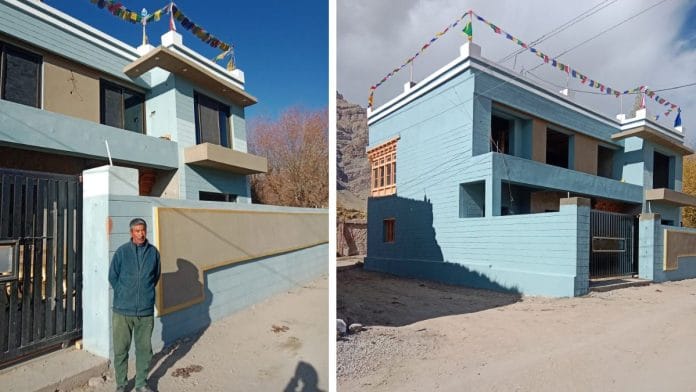New Delhi: Retired armyman Tashi Gailson’s long-pending dream to convert his ancestral home into a homestay is finally coming to life. A double-storeyed building with six rooms has replaced his small, semi-pucca house in Changa village, located on the banks of the Indus river in Leh district. The construction work is now in the final stages.
“This was made possible as I could get a bank loan of Rs 15 lakh against my property due to the property card issued by the government. Now, minor works are left, after which I will get the necessary permissions to start a homestay,” the 55-year-old, who retired from the Army in 2005, told ThePrint.
Gailson is one of lakhs in the country who have got cards for their residential properties in the village under the Centre’s Survey of Villages and Mapping with Improvised Technology in Village Areas (SVAMITVA) scheme.
Launched in 2021, the scheme is aimed at creating records of rights (RoR) in revenue documents for inhabited areas (as opposed to agricultural land) in villages. It is also meant to address land-related disputes, help villagers take bank loans against their properties and aid gram panchayats (GPs) in preparing development plans and collecting property tax.
A senior official in the Union Ministry of Panchayati Raj (MoPR), who did not wish to be named, told ThePrint that the scheme has helped unlock the economic potential of residential properties in villages which did not exist in revenue records, until now. “It is also helping states generate revenue from stamp duty, property tax, among others.”
Under the SVAMITVA scheme, Survey of India—the central agency for mapping and surveying—is preparing maps using drones and information provided by state governments about property owners after on-field verification.
Of 6.62 lakh villages in 30 states and Union territories (UTs), the scheme is being implemented in 3.44 lakh notified villages. West Bengal, Bihar, Telangana, Meghalaya and Nagaland did not participate in the scheme, and Tamil Nadu only conducted a pilot project under the scheme.
While the scheme was supposed to end in March next year, the Centre decided to extend it till March 2026 as several states are in the process of issuing property cards.
“Now that the Centre has extended the deadline till March 2026, we have written to states which did not implement the scheme to come on-board. The Telangana government has now decided to implement the scheme,” the official quoted above said.
Also Read: Central Vista museum committee ‘met only once’ since 2022. No clarity on artefacts’ destination
Over 2.4 crore property cards prepared
While the process of preparing village maps is almost over in states and UTs implementing the scheme, there are a few states where work is slow, senior ministry officials said.
“Drone flying for preparation of maps is almost complete in all states and UTs implementing the scheme. However, in a few states, including Karnataka, drone flying is pending in a large number of villages. The state government has now expedited the process,” a senior ministry official said.
According to data provided by the ministry, over 2.4 crore property cards have been prepared in 30 states and UTs. Apart from Karnataka, states such as Uttar Pradesh, Rajasthan and Punjab, among others, are yet to prepare property cards in a large number of villages.
For instance, Uttar Pradesh—which has the highest number of villages (over 90,000)—has prepared around 94 lakh property cards in 65,000-odd villages, according to the state’s revenue department officials.
Another issue in Uttar Pradesh is that the current legislation does not allow mutation (updating property records to reflect a change in ownership) of residential properties in villages.
“Till now, residential properties in villages were not registered under revenue records. It is only after the SVAMITVA scheme that we started issuing property cards to them. But we do not have a legislation to govern the transaction of land in residential areas of villages due to which the property cannot be transferred or sold to anyone,” another official in the MoPR said.
The official added, “We have sent a proposal for a new legislation called UP Abadi Abhilekh Adhiniyam, 2024 for approval. This will allow mutation of residential properties in villages.”
Scheme helping states boost revenue
Similar to Gailson, several other village residents are now availing bank loans against residential properties for reconstructing their homes and setting up businesses, a senior official with Madhya Pradesh’s revenue department told ThePrint.
Close to 38 lakh property cards have been prepared in Madhya Pradesh, he said, adding that it is not just property owners who have benefited from the scheme; state governments, too, are using SVAMITVA data to generate revenue.
“All land parcels in the abadi areas (residential areas) in villages are demarcated in land records now due to the SVAMITVA scheme. This has enhanced the property value both legally and financially, as people can get loans and also sell their properties legally. When a person sells his/her property and registers it at the sub registrar office, the mutation process is automatically triggered,” Rajendra Gole, deputy director of land records in the Maharashtra government’s revenue department, told ThePrint.
A senior official told ThePrint that with each residential property marked on the map under the scheme, it will help generate revenue from sale or purchase of these properties.
(Edited by Radifah Kabir)
Also Read: Plan changes & lack of clarity, what’s causing delays in Delhi’s Central Vista revamp project






